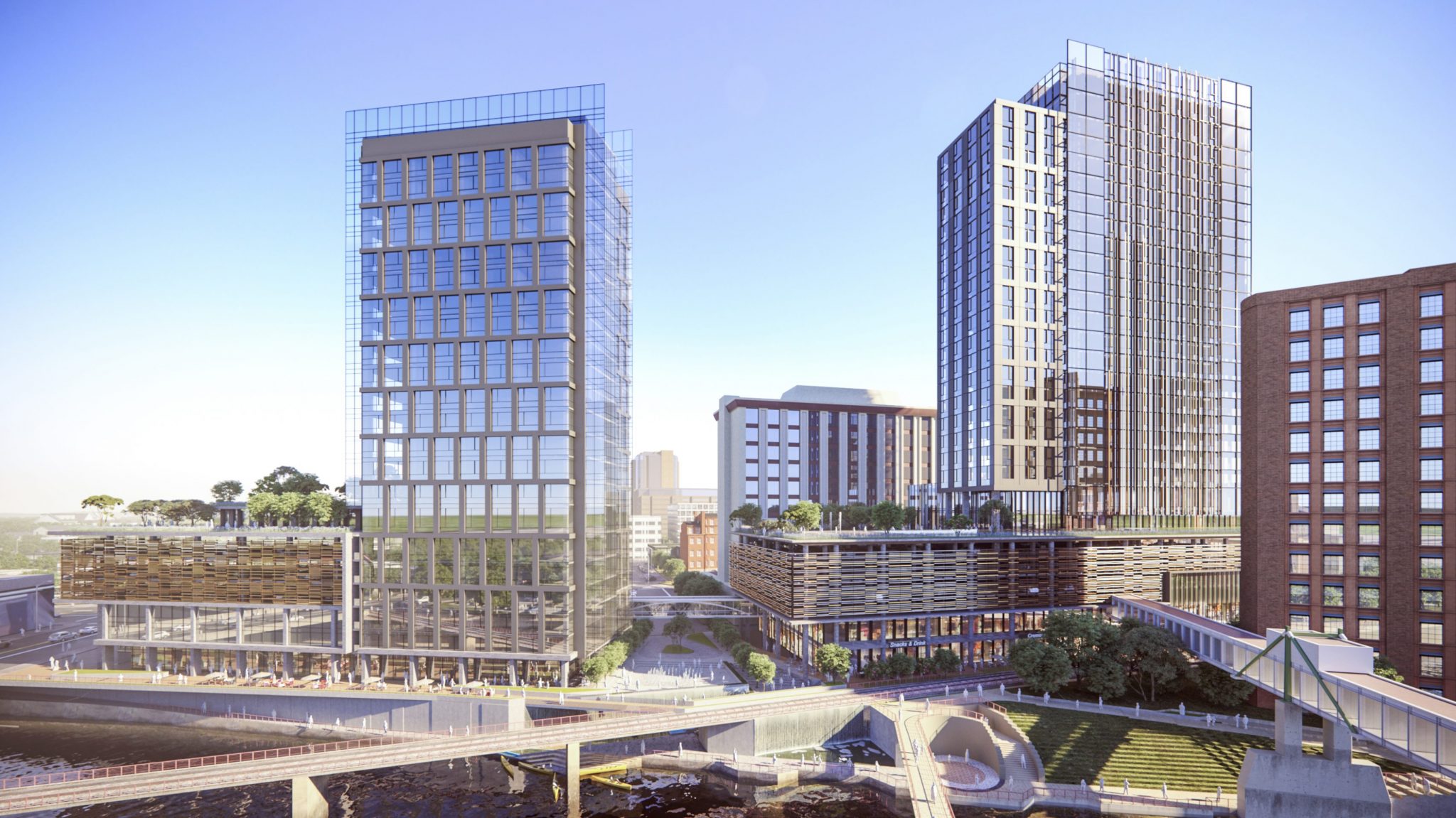Rethinking Rochester's riverfront
Forty years ago this month, Rochester was struck by the worst natural disaster in the area since the 1883 tornado that spawned Saint Marys Hospital. On the evening of July 5, 1978, strong thunderstorms unleashed five inches of rain in three hours, an astonishing pace that the already rain-swollen Zumbro River was unable to withstand. By the morning of July 6, water was pouring over the banks of the river throughout greater Rochester. The resulting disaster claimed five lives and caused $60 million in damage.
Because of Rochester’s geographical position in a valley, floods were nothing new to the Med City. However, after watching a quarter of the city become submerged in six feet or more of water, leading to massive power outages and infrastructural nightmares, city leaders had seen enough. With assistance from Congress and the U.S. Army Corps of Engineers, an intricate flood control system was approved — and after more than a decade of work and $115 million in funding, flood walls were finished in 1996, forever changing the layout of downtown Rochester.
Now, as the city turns toward the river in an effort to energize the downtown waterfront, those walls may pose new challenges to developers and Destination Medical Center efforts.
Hundreds of millions of dollars are scheduled to start pouring into the riverfront area in the coming years, but city officials and developers alike will have to decide what trade-offs are worthy between guaranteed safety and potential economic growth along the Zumbro.
How we got here
The design and creation of the flood walls was left to the U.S. Army Corps of Engineers, which placed a serious priority on safety over aesthetics and waterfront access — even though the aesthetic improvements won landscape and engineering awards. The walls protect Rochester from floods much worse than the 1978 flood, an event categorized as a 100 to 200-year event. In the present day, the Corps has become even more stringent on safety requirements in the aftermath of Hurricane Katrina.
Downtown Rochester during the flood of 1978 / Courtesy National Weather Service
Former assistant city administrator Gary Neumann, who helped oversee the creation of the flood control system, underscored the emphasis on safety as the driving force behind the flood walls.
“The priority in the channelized river area is to maintain or increase the capacity to move flood waters through the city without harm to our citizens and their property,” said Neumann.
The system has done that successfully in the past 20 years, most notably in 2007 and 2010, when flooding caused damage to communities across southeast Minnesota but left Rochester’s downtown unharmed.
What is possible?
In 2015, the public got its first glimpse at what the waterfront could look like in Rochester’s future. Initial renderings for Destination Medical Center showed a riverfront that looks nothing like what sits downtown today.
“Those images were intended to be aspirational, to make people think outside the box and get people a little uncomfortable,” said Patrick Seeb, DMC's director of economic development and placemaking. “They’re that bold. That image, and most of the main images used for DMC, none of them will probably be realized exactly as they’re depicted and they weren’t meant to be literal. They were partly intended to tell people, ‘Hey, you have a river here, and you’re not doing enough with it.’”
The images showed steps down to glittering, clear water, a light fixture below the water, and flood walls missing in some areas. The waterfront looked futuristic, exciting and on par with the DMC vision, but according to Neumann, there are significant hurdles to altering the concrete barriers.
“Changes within the channelized area that increase flood flow capacity can be considered,” said Neumann. “Changes that would decrease flood flow capacity or place obstructions in the channel that might lead to a blockage of the flood flows would not be permitted. This is one of the constraints and realities that the city has had to work with during the construction of the flood control project.”
Nick Campion
City Council Member Nick Campion acknowledged the flood walls have done their job when it comes to protecting the community, and said anything that undermines the safety of the public would be a non-starter for the city.
Still, Campion believes there are opportunities yet to be explored.
“We have world-class engineering and architectural firms out here looking at what sort of projects could happen," said Campion. "I can’t imagine, in all that brainpower, people can’t show me something that makes me excited about the opportunity to engage with the waterfront.”
The first steps
As new development starts to trickle into downtown, the flood walls will play a major role in shaping the contours of Rochester’s waterfront. Already, the $250 million Bloom International Realty proposal, which would feature two towers stretching along the Zumbro River from 4th Street to 2nd Street Southeast, was altered when city officials expressed concern over plans to punch through the flood walls to give residents direct access to the river.
As Jonathan Golli, the Pittsburgh-based architect hired by Bloom to lead the project, said at a neighborhood meeting earlier this year: "We don’t want to touch anything that the Corp of Engineers did for flood control."
Cities like Augusta, Georgia and Wilkes-Barre, Pennsylvania successfully punched holes in their flood walls that can be re-sealed in case of a flood, but a feasible way to keep downtown Rochester safe could prove costly.
“The Corps really builds things to last,” said Neumann, “and there would be significant costs to make changes to portions of the project where the channel walls are in place.”
Bloom still plans to add a public plaza and provide views of the river, among other public amenities, but Campion still wants to see more offered before public funding goes into the construction of the project.
“At preliminary reviews, you hear me saying ‘I consider the waterfront to be critical to the public benefit of the project,’ and that’s intended to be the message. When you come back to look for public investment, you should be very considerate of what sort of development’s going to take place,” said Campion.
Rendering of the proposed Bloom project / Courtesy AE7
With the flood walls in place and a requirement from the city to provide some sort of waterfront activation, DMC projects will have to work within the confines of the existing infrastructure.
“It’s about putting a front door of sorts on the river,” said Seeb, who led the St. Paul Riverfront Corporation for 20 years before coming to Rochester. “And [the Bloom project] will have food and beverage right on the river. That’s an activation level that other examples don’t offer.”
The Bloom project, while it moves through the approval process this year, won’t be ready to serve tenants and visitors until the 2020s. In the interim, ideas are being discussed on how to activate the waterfront and improve its aesthetics.
Among the ideas that have been brought forward is a concept from Rochester resident Kelly Kirkpatrick to add vertical gardening plots to the walls. The food, according to Kirkpatrick, could be then given to low-income residents in the area.
“I love the idea of prototyping,” said Campion. “Often, our best ideas come from the community."
Why the river matters
Both DMC and city officials recognize the importance of an activated waterfront in Rochester’s future — as does Whitney Clark, the executive director of Friends of the Mississippi River, an organization dedicated to the protection of the Mississippi River in the Twin Cities area.
“Without public access,” said Clark, “people don’t necessarily know or care about the river. The more that you open it up for access — boats, trails, etc. — the more people start to care about the river and see it as an amenity.”
Patrick Seeb
One main issue in activating the waterfront has nothing to do with the flood walls, but with the water itself. It’s no secret that the Zumbro River’s water quality is less than stellar downtown, but officials say there are opportunities for improvements. A proposal to add filters to storm water before it deposits into the Zumbro, according to officials, could enhance the river’s color and odor as it meanders through town — as well as slowing the runoff rate during storms, further lowering the flooding risk.
“Storm runoff is what makes the river so dirty,” said Seeb, “so we have to start cleaning the water before it goes into the river. That’s job number one: clean the water.”
As the city grapples with how to successfully activate the riverfront to the benefit of residents, visitors and developers — without jeopardizing the integrity of the flood walls that virtually guarantee safety — Rochester may be changing its collective opinion on the river that devastated the city four decades prior.
“Minnesotans have always been proud of their water — the more we connect people with the water, the more they’ll care,” said Campion. “We get stuck in this bureaucratic mass of, ‘everything is hard so it’s impossible,' we won’t achieve the vision for the waterfront ... I think we need to find ways to innovate and to bring along our partners, and frankly, people who have worked very hard to keep our community safe like the Army Corps of Engineers.”
Isaac Jahns is a 2015 graduate of Mayo High School and a current journalism student at the University of Missouri. His main passions are writing music and telling people’s stories. Follow Isaac on Twitter.












